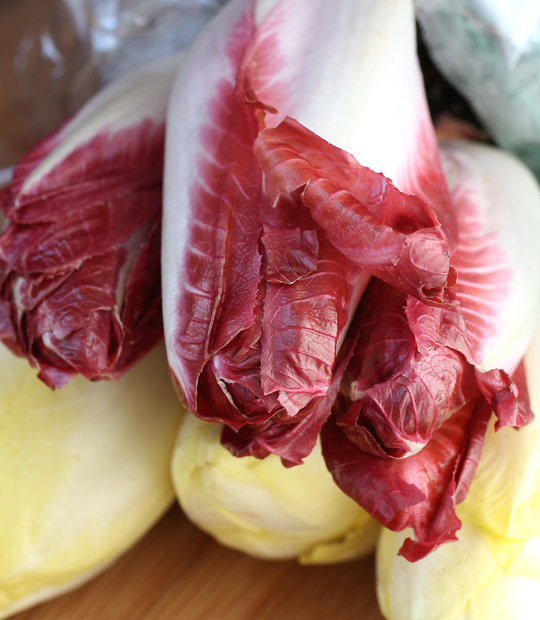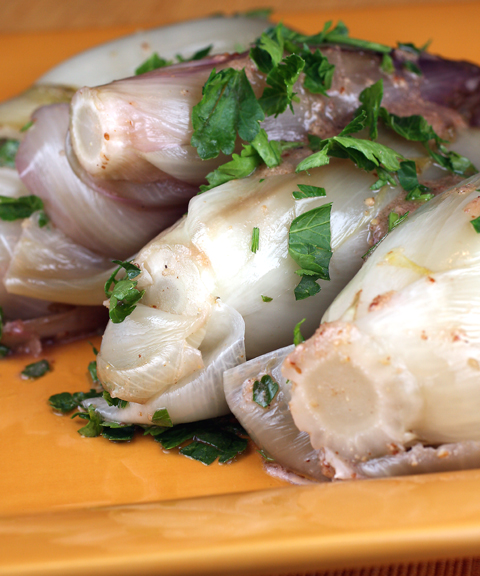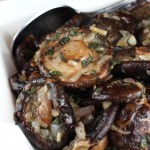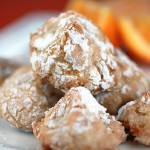En-dive or On-deev?
I sheepishly admit that I always thought either pronunciation was correct. In fact, I thought only those know-it-all-types who speak with their pinkies held high in the air actually refer to this distinctive member of the chicory family as “on-deev.”
How wrong I was, as Rodger Helwig, so kindly set me straight by telling me there is a difference after all. Helwig is the spokesperson for California Vegetable Specialties of Rio Vista, Calif., the only producer of endives in the United States. It sells more than 4 million pounds of red and white endives each year.
The elongated Belgian endive with its slender, smooth leaves packed tightly together, and which is grown in the dark, is pronounced “on-deev.” Because it hails originally from Belgium, it is pronounced the French way. On the other hand, curly endive with disheveled, wild leaves, and which grows in light, is pronounced “en-dive.”
It’s not surprising that there’s only one producer of endive in this country, given how difficult it is to grow. Indeed, it must undergo two growth phases before it is ready for market. In the first phase, the endives are in the ground outdoors for 150 days, where it grows from seed to root. Next, the top of the plants are lopped off, the roots dug up, then placed in cold storage to enter a dormant phase. Then, the roots are removed from cold storage for their second growth, which is done hydroponically and takes place in a dark, cool and humid room. They are left to grow for about 28 days before they are dug up for market. Because of this process, endives are available year-round in this country.
Helwig is hoping more Americans will discover the versatility, and wonderful crisp, nutty, slightly bitter taste of endive. Europeans love the stuff, consuming 13 to 15 pounds per person a year, he says. Americans, though, eat merely an ounce a year.
California Vegetable Specialties recently sent me a “bouquet” of endives — with their bottom roots still attached, and all bundled up in cellophane like flowers — to play around with. I especially enjoy endive raw. It’s perfect in salads, with its leaves separated and cut, then tossed with tangerines, pomegranate seeds or ripe pears. It’s also makes for great party food when you separate the leaves, which form almost little canoes to hold all manner of dips or dollops of seafood salad.
But this gave me a chance to cook endive, too, which I don’t often do, just because I’m so partial to it raw.
“Braised Endive in Mustard Vinaigrette” is from “The Martha Stewart Living Cookbook, The New Classics” (Clarkson Potter) by the editors of Martha Stewart Living. This recipe appealed to me because I can never resist the assertiveness of a strong vinaigrette and because I was intrigued by the technique of cooking the endives in chicken stock before dressing it.
This makes for a super easy side dish. As the endives cook for about 20 minutes in the skillet with the stock, you can make the quick vinaigrette — a basic blend of mustard, red wine, extra virgin olive oil.
Once the endives are cooked, blot them dry, then toss with the dressing before garnishing with chopped parsley.
The chicken stock mellows the bitterness of the endive, softening and rounding out its flavor. The vinaigrette adds a bold punch.
Helwig jokes that he doesn’t really care if you call it “en-dive” or “on-deev.” He’s just happy if you eat it.
Braised Endive in Mustard Vinaigrette
(Serves 4)
1 tablespoon unsalted butter
1 1/2 pounds Belgian endive (about six heads)
3 cups homemade or low-sodium store-bought chicken stock
1 1/2 tablespoons grainy mustard
2 tablespoons red-wine vinegar
Coarse salt and freshly ground pepper
1/4 cup extra-virgin olive oil
1 tablespoon finely chopped fresh flat-leaf parsley, for garnish
In a large skillet, melt butter over medium heat. Add endive, and cook, turning occasionally, until browned on all sides, about 5 minutes. Pour stock into skillet; bring to a boil, and cover. Reduce heat to medium-low, and simmer, turning endive occasionally, until just tender; about 20 minutes.
Using a slotted spoon, transfer endive to a paper-towel-lined plate; discard the stock. Pat the endive dry, and set aside.
Make dressing: In a small bowl, whisk together the mustard and vinegar. Season with salt and pepper. Whisking constantly, pour in the oil in a slow, steady stream; whisk until emulsified. Gently toss each endive in the dressing, coating well. Garnish with the parsley, and serve at room temperature; set any dressing on the side.
From “The Martha Stewart Living Cookbook, The New Classics” by the editors of Martha Stewart Living
More Veggie Sides: Green Bean Salad with Pickled Shallots
And: Eric Ripert’s Sauteed Shiitake Mushrooms with Sage
More Martha Stewart: Peanut Butter & Jelly Cupcakes








I always pronounce it “en-dive” in English and “on-deev” in French… A very original way of preparing that veggie which I love.
Cheers,
Rosa
Wow. I had no idea that each was intended to refer to a different variety. The explaination makes sense though. Who knew!?!
Interesting to learn the differences of which is pronounced which way, but I have to say, I’m still not sure if I would know which one is the curly dishelved endive. Most of the ones I see at the stores look like on-deevs. 😉
Single Guy Ben: You probably know it more than you think. For instance, frisee is a type of endive that would be pronounced “en-dive.” 😉
Very interesting about the 2 pronunciations. I’ve always said it as “on-deev” but now I know! I’m also a sucker for anything with endives. 🙂
I’m definitely going with en-dive and I love the stuff! I usually use it as a scooper for dips. Good AND good for you!
Hmmm…guess I’ve been using on-deevs all this time. Good to know! 🙂
Wow, I’ve always called them endive, curly or not. 😛 And I’ve never tried it anyway but raw either. Now I know… but just checking, are the ones in your picture on-deevs?
Can I have Door Number Three, please? I’ve always heard/said “on-dive” for the tightly bundled stuff — and never even knew there were other members of the same family. Frisee by any other name is not a favorite of mine, but now we know. Huzzah for another day in which something new has been learned about this wonderful wide world of ours!
Oooh, and I suppose you are further educating us that it’s one of those words which is inherently plural. One head of endive would be “an endive”, but many braised heads also equate to “the endive are cooked” instead of “…the endives…” (I know you well enough to believe that was not a typo, Carolyn!) But do we not speak of various varieties and numbers of lettuce as being “lettuces”? (groan) Clearly this is reason #4,738 why I could never be a food writer!
Carroll: Actually, I think YOU are educating us. I looked on the endive.com site and Wikipedia, and both appear to use the plural of “endives.” However, Martha, in her recipe, appears to use “endive” for the singular and the plural. So, I have corrected my post to reflect “endives” as the plural, except with Martha’s recipe, which I left as it appears in her book.
Thank you , thank you, thank you. I have always said on-deev and either been mocked or thought of as snooty! So, thank you for validation that my pronunciation was correct all this time!
I need to try braising the endives, sounds like a terrific preparation, wonderful with the mustard vinaigrette.
And that research you did, Carolyn, is my reason #4,739!
But, this is actually pretty intriguing. I’m asking myself, is it an issue inherent to leafy green vegetables? Or based on the way they grow?? We certainly say “spinach” not “spinaches”, but that’s because it grows as individual leaves, yes? Brussels sprouts…well, who in their right mind would cook just one “sprout”? Even were we to pull the leaves all apart to stir-fry them, we would be directed to “add the brussels sprouts and…” even though instructions for the same dish, were it made with spinach, should advise us to “add the spinach and…”.
No wonder people not born hearing/speaking this crazy language of ours occasionally have difficulty making sense out of the non-existent “rules”. Aieee!
Had no idea these were so tricky to grow. I have never had braised endive & now I am tempted to 🙂
Hehe I never really thought about it. I suppose I call it en-dive 😛 I don’t mind it but mostly with a sweet sauce (I had them poached in orange juice and other flavours and it was divine) as I find it a bit too bitter otherwise. This sauce sounds great too!
and here i was thinking that on-deev was just the hoity-toity pronunciation–glad you corrected me! 🙂
I have to admit, I always wondered that too. Great recipe 🙂
*kisses* HH
I will keep pronouncing it en-dive in the US and on-deev in French speaking countries.
I think Roger gave you the pretentious, but proud, answer. He markets them, seems reasonable enough.
According to Merriam-Webster (the only true expert on the matter), both “awn-deev” and “in-dive” are correct pronunciations.
Huh, I had no idea, either! Thank you so much for the clarity, hopefully I won’t embarrass myself with the incorrect pronounciation again.
Interresting post !!
I’m French and Endive is a specialty of the North of the country. The Picard are very proud of Endive called also “Chicon” by the way. They use one type which named “chicorée” mixed and dryed into their coffee. It’s delicious but very scpecial taste.
Personaly, I love endives (chicons) and it’s delicious in a pie, cake, or salad !!
Thank you for this post !!
I don’t disagree with this blog post!